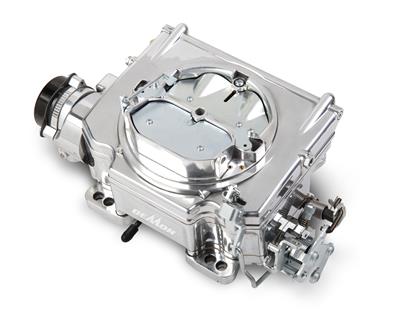I agree with testing the vacuum advance diaphragm for leaks. Put a Mighty-Mite type hand pump on it and see if it holds vacuum. Harbor Freight has an inexpensive model. Otherwise, I can't see how connecting the vacuum line would make a radical difference in how it idles. I never notice a difference other than with a timing light, and it shouldn't make any correction at idle, only as you rev on the low end. Even if you connected to straight vacuum, it should make little difference. Many Jeep owners do that purposefully so they don't get a bog off idle. I assume that when you don't have the line on, you plug the port. If you leave it sucking air, let us know since that is a big clue if it runs better that way.
Most people have a love/hate relationship with carburetors. It is probably more due to problems with individual ones or misapplication than design issues. It is hard to know what is going on inside one. The biggest misapplication is "over-carbing", i.e. selecting one too large. The least sensitive to over-size are spread-bore designs with tiny primaries - Carter Thermoquad and Rochester Quadrajet. The Thermoquad was standard on many Mopar engines from ~1972+. Though rated 800 cfm, I understand essentially the same model was used on the smallest V-8's. The Quadrajet was mostly GM, but on some Mopars in the 80's. While many FABO love Thermoquads, good ones are rare, parts are expensive, and it is a learning curve to tune them.
The biggest downside of spread-bores is that both have mechanical secondaries. If you "floor it" at low speed, you open up the secondaries which gives poor fuel atomization. The cure for that is "vacuum secondaries", which is mainly Holley models. The carb has a "mechanical computer" which operates the secondaries based on need (air flow). I think those are only in a "square-bore" pattern.
Most factory intake manifolds fit only a spread-bore or square-bore, not both. You need adapters otherwise, and must correct for the added height (hood clearance, divorced choke fit, etc.). Most aluminum after-market intakes can mount either. Changing carb models seems easy until you deal with throttle and tranny connections, varying fuel inlet locations, and choke connection. Be careful with some carbs. Holley made "spread-bore replacements" that look like a square-bore (almost equal sized primaries & secondaries), but they won't fit a square-bore manifold.
What do I have? Most of the above to try on my 273 and 383, plus some Holley TBI units. Just for experimenting and testing mileage. You can always sell them again on ebay for close to what you paid.

















